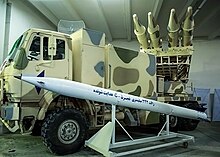Fajr-5 (artillery missile)
The Fajr-5 ( Persian فجر, Early light or dawn ) is an Iranian artillery missile .
development
The Fajr-5 was developed in the early 1990s on the basis of the Chinese WS-1 artillery missile. The development and production takes place at the state armaments company Defense Industries Organization (Persian: سازمان صنایع دفاع). The first systems were ready for use from the mid-2000s.
technology
The rockets with caliber 333 mm are spin stabilized and have four stabilizing wings at the end of the missile. The twist of the rocket is created by the pulls in the launcher tube during launch . The rockets are 6485 mm long and have a launch mass of 915 kg. The maximum range is 75 km, the maximum spread of a rocket salvo is 4% of the operational distance. At the maximum operational distance of 75 km, this corresponds to a scattering circle radius (CEP) of around 3 km. Therefore, the Fajr-5 is only suitable for combating area targets. As an artillery missile, it does not have its own homing system, but according to the Iran Aerospace Industries Organization (AIO) an upgrade would be possible. The Mk1 missile's fragmentation warhead is detonated by a proximity or impact fuse. The fragmentation circle is around 44 m. The bomblet warhead of the Mk2 missile distributes the bomblets in a circular area around 200 m in diameter.
The following types of missiles exist:
- Fajr-5 Mk1 : 175 kg fragmentation warhead with an explosive content of 90 kg.
- Fajr-5 Mk2 : 289 bomblets (submunitions) with combined fragmentation and armor-piercing effects. A bomblet weighs 450 g, has a fragmentation circle of around 7 m and can penetrate 80–100 mm armor steel .
- Fajr-5 Mk3 : Incendiary warhead filled with phosphorus .
The rockets are housed in four juxtaposed tubes in a horizontally and vertically swiveling arm that is located above the rear axle of a three-axle Mercedes truck . The vehicle has a mass of 15 t and reaches a top speed of 60 km / h. The missiles can be fired at an interval of 4 to 8 seconds. An empty turret is reloaded with a crane and takes around 10 minutes.
commitment
It was used in the Israel-Lebanon conflict in 2006 ; Hezbollah fired the Fajr-5 on Israel for the first time on July 29, 2006 . The city of Afula, south-east of Haifa and around 50 km from the border with Lebanon, was affected . According to Israeli information, the most southerly hits by Hezbollah rockets so far occurred, even though Grad rockets had already hit Afula . Hezbollah calls the missile Khaibar-1 ; the Israeli side claimed that this was a modified Fajr-5. With its range of 75 km, it is superior to the Palestinian Qassam missile (up to 20 km) and the Grad missile (approx. 50 km, Hezbollah's primary weapon in its attacks on Israel) and thus poses a threat to the Israeli heartland Fired from the Gaza Strip, this type of missile can also reach Tel-Aviv. On July 9, 2014, three M75 missiles struck near Dimona . They were fired from the Essedin-al-Qassam bridgades of the radical Islamic Palestinian organization Hamas . The goal was the nuclear facility .
distribution
See also
Individual evidence
- ^ Vital Perspective: North Korea. Retrieved March 21, 2008.
- ↑ armyrecognition.com , Accessed March 21, 2008.
- ↑ tagesschau.de: Report "Hezbollah fires Fajr-5 rocket for the first time " + pictures (tagesschau.de archive)
- ↑ Israel: Rockets hit the Dimona nuclear facility. In: Spiegel Online . July 9, 2014, accessed June 10, 2018 .
- ↑ Fajr 5 (الفجر). In: @klkamashiq (Twitter). 2017, accessed November 20, 2019 .

